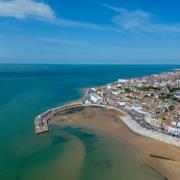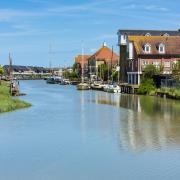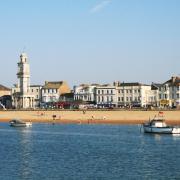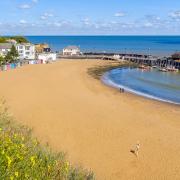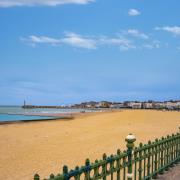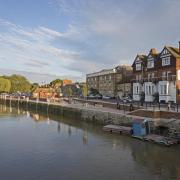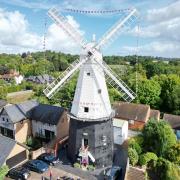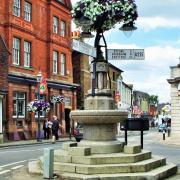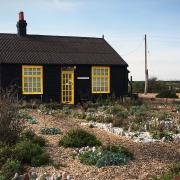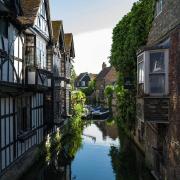Writers from Edith Nesbit to Russell Thorndike and Malcolm Savill have all been influenced by the timeless quality and rare magic of Romney Marsh.
Even on a glorious summer day, when the sun is high in the sky and the landscape shimmers in the he...
Writers from Edith Nesbit to Russell Thorndike and Malcolm Savill have all been influenced by the timeless quality and rare magic of Romney Marsh
Even on a glorious summer day, when the sun is high in the sky and the landscape shimmers in the heat, an air of mystery and menace hangs over Romney Marsh. Distant church towers recall its ancient past, and the new wind turbines, silent skeletal monuments to 21st-century energy production, add a sense of drama to this wonderfully evocative setting.
With its rare beauty and tangible atmosphere, it's hardly surprising that all kinds of writers have been drawn to Romney Marsh over the years. One man in particular who really put the place on the literary map was author and actor Russell Thorndike, brother of Sybil, a distinguished dame of the British theatre. Thorndike, who as a child was a chorister of the Chapel Royal and sang at Queen Victoria's funeral, lived at Dymchurch and wrote some of the Dr Syn stories in the bar of the 16th-century Ship Inn in the High Street.
Since the first book was published in 1915, the eponymous Christopher Syn has entertained Thorndike's readers by living an enthralling double life. Dr Syn is the genial vicar of Dymchurch by day, notorious smuggler by night.
Niko Miaoulis, who has recently acquired The Ship, is a dedicated fan, and is gradually transforming the pub into something of a Dr Syn shrine. Posters of the film versions of Dr Syn and paintings by local artist Terry Anthony reflecting Romney Marsh's deliciously dark past line The Ship's ancient walls. The duo plan to build a 20-metre high scarecrow on the marsh as a local reference point (Kent Life, July, page 129).
Niko has also been busy promoting his book Life on Marsh, which looks beneath the surface at this land of myth, magic and legend. "The seven Dr Syn stories have been largely forgotten in recent years," he explains.
"My intention is to revive interest in them and bring fans to the area. The books are rumbustious, evocative and exciting and the setting is magical. I drive across Romney Marsh every day and see it in different moods and in all weathers. I can see why Russell Thorndike loved it so much.
"It's fascinating to think he wrote much of the saga in this very pub, not surprisingly once a renowned haunt of local smugglers, and also took names from gravestones across the road in the churchyard of St Peter and St Paul for characters in the books."
A former engineering manager, The Ship's Greek landlord says that many Americans visit the pub as part of a Syn pilgrimage to the area.
"There are three big-screen versions of the stories, one of which was made by Disney and shot on location on Romney Marsh," says Niko.
"It's ironic that, thanks to Disney, Christopher Syn is probably better known in the USA than here. That's partly why I want to try to relaunch him into the public consciousness."
Next August, the biannual 'Day of Syn' will be staged in Dymchurch.
This colourful event dates back to 1963 when urgent funds were needed to repair the roof of St Peter and Paul church. Locals decided to hold a pageant and f�te based on the Dr Syn stories.It proved so successful that the festival quickly became an integral part of the community calendar.
Villagers don 18th-century costume and re-enact scenes from the books. Various charities are represented and thousands of visitors make their way here to celebrate the Day of Syn.
The shadow of Russell Thorndike's richly drawn character falls across much of Romney Marsh, but the region has strong links with other writers. Just yards from The Ship is Sycamore House, one of half a dozen different homes in and around Dymchurch occupied by the writer Edith Nesbit, who is best remembered for writing The Railway Children, published in 1906.
From Dymchurch, I travel the short distance to St Mary in the Marsh, one of a number of much-loved medieval churches on Romney Marsh.
Churches seem to dominate this crumbling landscape and, inevitably, my literary exploration of it. On the right as you enter the churchyard is Edith Nesbit's grave, marked by a simple wooden structure.
Born in London in 1858, Nesbit played a key role in the 'golden age' of children's literature, alongside such luminaries as Kenneth Grahame and Beatrix Potter. She was also a founder member of the socialist Fabian Society.
As a child, Edith Nesbit (professionally, she preferred to be known simply as E Nesbit) lived for three years at Halstead on the North Downs. The house was near a railway cutting, which may have given her the idea for The Railway Children, Nesbit married twice - her second husband, Thomas 'The Skipper' Tucker, was a widowed marine engineer from a markedly different social background.
Her older children disapproved of his broad cockney accent. However, Tucker was devoted to his new wife and her bohemian lifestyle and when their home, Well Hall at Eltham, became too expensive to maintain, they moved to two former army huts, known as The Long Boat and The Jolly Boat, on Romney Marsh.
Known as the 'Duchess of Dymchurch', Nesbit would lie back in her four-poster bed and look wistfully across the marsh towards her beloved "little low hills of Kent." Today, 85 years after Nesbit's death, her stories are still read and remembered with affection - especially The Railway Children, which has been successfully adapted for film and television in recent years and has never been out of print.
It even gets a mention in one of C.S. Lewis's Narnia books and in The ABC Murders, an Agatha Christie classic featuring her much-loved Belgian detective, Hercule Poirot.
My tour of Romney Marsh leads me from Edith Nesbit's final resting place to 12th-century Old Romney church, with its walls of Kent ragstone and striking Georgian box pews painted pink. This innovation dates back to the 1960s when one of the Dr Syn films was shot here. The parishoners liked the somewhat startling shade so much they asked if it could be kept for future generations of worshippers.
A couple of miles from Old Romney lies the village of Brookland, with its church dedicated to St Augustine. Yet again there are echoes of the Dr Syn stories and the character's official role as country parson. In one corner of the church is a fascinating example of an 18th-century grave shelter, or hudd, originally designed to keep the rain off the clergyman's wig during burials.
Romney Marsh features prominently in several of the Lone Pine series of children's books by the Sussex-born author Malcolm Saville, who died in 1982. Saville puts strong emphasis on place in his writing and includes vivid descriptions of the English countryside. He even makes reference to the wooden belfry in Brookland churchyard.
The books have echoes of Enid Blyton's Famous Five adventure stories, with Saville's teenage characters herocially doing battle
with 20th-century smugglers and crooked antique dealers.
In Treasure at Amorys, the 15th Lone Pine adventure, much of the action takes place on the Isle of Oxney near Appledore, with an intriguing plot focusing on the Roman altar to the heathen god Mithras in Stone-in-Oxney church.
When Saville returned to Sussex in later life, he visited Oxney once more and resolved "to write a story of today linked with a part of our history."



